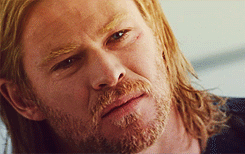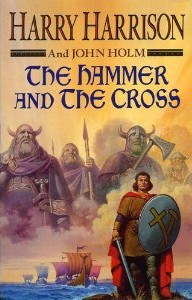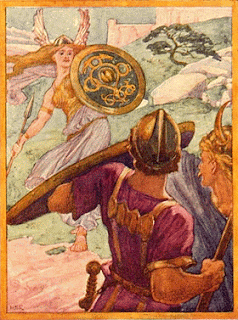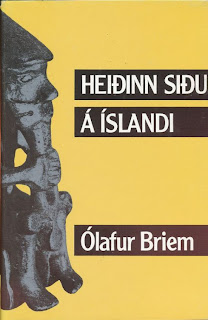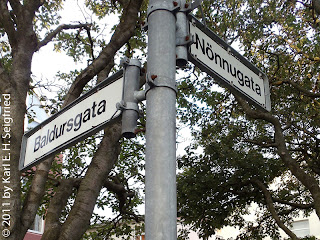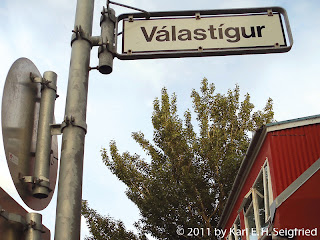For several years, I've been wondering about heathens in the US military. When I say
heathens, I mean those who follow the contemporary iteration of Norse religion that is sometimes known as Ásatrú. For instance, I’ve had questions about the accuracy of data regarding adherents of various minority faiths within the military. I’ve come across small bits of information about the Department of Veterans Affairs forbidding the appearance on grave markers of
Thor’s hammer (probably the most popular religious symbol for historical and modern heathens), but I discovered nothing definitive. I wasn’t able to find detailed answers to my questions – until I met Josh and Cat Heath.
![]() |
| Josh & Cat's heathen wedding in Denmark (2009) |
Born in Laconia, New Hampshire and raised in nearby Holderness, Josh was on active duty in the US Army from 2006 to 2011. He served as a Quartermaster and Chemical Equipment Repairer / General Mechanic and was deployed during Operation Iraqi Freedom in 2008-2009. He’s currently serving his last few months with the US Army Reserve while studying Political Science and French as a full-time student at Marist College in Poughkeepsie, New York, where he is also working to develop the school’s Veterans Liaison Office.
Cat was born in Chorley, Lancashire, England; the US is her seventh country of residence. She earned a BA with Honors in Modern Languages (French, Spanish and Portuguese) at the University of Newcastle-Upon-Tyne and met Josh while he was stationed in South Korea, where she was teaching kindergarten. The couple moved to Germany and had a civil wedding before Josh was deployed to Iraq. After his return a year later, the couple had a heathen wedding ceremony in Denmark. Cat currently works “as a corporate slave” but is also planning an escape via her translation business.
Together, Josh and Cat have been deeply involved in American heathenry and have played important roles in the struggle for its recognition as a religion in the US military. In 2010, they founded the
Open Halls Project, an organization “set up to connect military heathens with civilian and military heathens throughout the world.”
KS – What is reconstructionist heathenry?
JH – It’s a process of breaking down all the information we have about historic heathen worldview and then trying to make that worldview work in the modern day. In some ways, it’s easier to say what it
isn’t. Reconstructing heathenry is not reenactment. Reconstructing heathenry is not doing the same things that our ancestors did. Reconstruction in heathenry is about understanding why the ancient heathen peoples did what they did and applying that thought process to the building of religious ceremonies and customs (also known as
sidu), today. There isn’t really such a thing as reconstructionist heathenry; different heathens have done differing levels of reconstruction. The movement to do more reconstruction has gotten stronger in the last ten years or so, and this movement has erroneously been called reconstructionist heathenry, when really it’s just heathenry with a focus on understanding and implementing a traditional worldview.
![]() |
| Swedish artist Carl Larsson's (highly imaginative) vision of ancient blót |
For example, we don’t know exactly how a blót [Old Norse “sacrifice”] was done in heathen times. We have a lot of archaeological information and we have a load of textual information about what became outlawed during Christian times, and we can extrapolate a lot of great information from all the research that has been done. The key, at least how I understand it, is that blót (and really any sacrificial ceremony in heathenry) is about creating a cyclic gifting relationship between the gods and ourselves. These same relationships can be built with the landvættir [Old Norse “land spirits”] and our ancestors, and I think it’s been a key part of recent advances in heathenry to focus on the fact that those relationships are, in a lot of ways, more important than the one with the gods. Our ancestors care about us, because we are more closely connected to them – the same with the landvaettir. They live with us; that relationship is like having a good connection with your neighbors. I like having a good relationship with the mayor, too, but if I don’t get along with the dude next door, that would impact my life a lot more.
Others might have a different view of Ásatrú or heathenry and how reconstruction fits into that. I know for a fact that some of my close friends don’t always agree with me, but I think that’s important. We don’t agree, but we can discuss all of the concepts together and really get into quality debates and help each other work out some thoughts and concepts.
CH – Reconstructionist heathenry is very misunderstood, and – as someone that’s often associated with it – I tend to find myself having certain “accusations” leveled at me. Most of the time, these center around how we’re all apparently “soulless” and just slavishly following what them there dusty old books say, that we apparently don’t have any of that UPG [Unverified Personal Gnosis, or mystical experience] stuff, and that we’re all mean and intolerant.
![]() |
| Self-portrait of Cat Heath |
I did used to get quite annoyed by these accusations, but now I see them more as being indicative of the misunderstandings that exist out there about reconstructionism. As my husband said, sometimes it’s better to try and explain reconstructionist heathenry by what it is
not, and, for some reason, some of what it is perceived to be
not is often offensive to others, too. My husband has talked a little about the process that reconstructionists engage in, and I believe that reconstructionism is something that
all heathens engage in; it’s just that some engage in it to a greater degree than others. However, having said that, heathenry suffers just as much from the curse of labeling as any other group on earth does. The reasons why we humans label each other are mostly just for identification purposes, but sometimes we label as a way of devaluing a group so that we don’t have to listen to anything they have to say. This is what I believe has happened in both the “anti-recon” and “recon” camps that seem to have sprung up. Trying to figure out what came first here is probably one of those “chicken and the egg” type scenarios – i.e., did the labeling create and reinforce group identities, or did already extant group identities lead to the labeling?
Either way, groups that are more reconstructionist in nature do have some differences. We tend to be more locally and community based (as opposed to playing on the national stage) and tend to focus on building up traditions over the years that can be handed down to our children. In terms of internet interactions, we also tend to stick to discussing subjects that can be backed up by sources, which admittedly can lead to the impression that we’re somehow “anti-UPG,” but we’re really not. Some of my most treasured UPG conversations have been with “recons” at the end of a night of revelry and with a drink in hand. We just tend to keep it to ourselves or among trusted friends and, in the age of Facebook, Tumblr and whatever else that encourages us to share every single detail of our lives for public consumption, is there really anything wrong in keeping some things – moreover things we consider
sacred– more private?
KS – How is reconstructionist heathenry different from other iterations of Norse religion in the last half-century?
JH – Reconstruction is a technique, it isn’t really a type of religious practice. From that perspective, it’s just another way of getting at information to help forge a modern Norse religion. Having said that, I think the biggest difference is we are trying to get away from the universal ideas that most modern heathens started with.
Heathenry in Iceland is different from heathenry in the UK, is different from heathenry in the Northeast of the US, and is likely different from heathenry in Australia. There isn’t anything wrong with that! That’s a good thing. The regional differences of practice are important. Regional religious expression was different throughout the [historical] heathen world. However, we are all working from the same base information set, so even if what we do is different, why we do it should generally be the same. It’s the worldview that is important, not the structure of blót or worship event.
![]() |
| Even thunder gods need help with the ladies, sometimes. |
This is the biggest issue I’ve had with books written by heathens. They often write out “this is how you do a ritual blót,” instead of writing “this is the worldview surrounding
why you do blót.” Then, instead of explaining why we think our ancestors are directly important to us, some folks simply say a particular ancestry is important. No, it doesn’t matter where your ancestors came from. If you lived in a heathen tribe in the old days, and you grew up there, you knew their way of life. You were a heathen. Period. Honoring our ancestors is thanking them for the actions that they took that have led us to where we are today. Old Spice has a tagline on their products: if your grandfather didn’t wear it, you wouldn’t be alive today. Cheeky and a bit odd, but totally true in this context.
CH – The biggest difference I can think of here is that non-Norse-focused groups (like Germanic or Anglo-Saxon heathens) tend to be more of a reconstructionist nature. Well, other than those “Seax Wicca” people, but we don’t talk about those. They’re like
Fight Club; we just don’t talk about them. Other than that, though, I agree with my husband – it’s just a method that happens to have led to the creation of some really cool groups and interesting customs.
KS – How did you two come to the form of heathenry you practice today?
![]() |
The Hammer and the Cross
by Harry Harrison & John Holm |
JH – It was the year 1994 or 1995. I had just read a great book called
The Hammer and the Cross by Harry Harrison (may he never be forgotten). I seriously liked it, and I wondered why there weren’t people still worshipping the Norse gods. I kinda left it at that, as well as a 5th grade “research” paper on the Vikings and their religion and travels. That summer, I worked as a volunteer at the local library and came across a term in a book that I couldn’t pronounce, but I was totally sure it was my new religion. That word was
Ásatrúarfélagið [“Æsir Faith Fellowship”], and – really truly at the time – I had no idea what it meant or said, except the definition was belief in the Norse gods in Iceland. Simple as that, I was hooked and, with internet acces, I learned about another easier to pronounce word:
Ásatrú. I read the websites at the time, learned about the Nine Noble Virtues [a list of moral guidelines created by English heathens in the 1970s] and called it a day. From then till 2004, I met only two other heathens, and I was not impressed by them. So, I wasn’t really much of a heathen. I said I was Ásatrú, but I didn’t really make offerings regularly, and I didn’t even really know all that much.
Sleeping in your car changes your life. I sat down and made a ten-year plan while I was living in San Diego in my car. Part of that ten-year plan was to really make Ásatrú/heathenry a part of my life. Not just to believe in it, but to truly live it. I popped back on the internet and began doing some searching again, and I came across several very bad websites – all of them racist garbage. At that point, I almost gave up looking for heathens that were worthwhile, again.
![]() |
| The battle-cry of Asatru Lore: "Cite your source!" |
Then I stumbled across [the online forum]
Asatru Lore. This site was a major impact on my heathenry. This is where I first learned about recon. This is the site that drove me to really start reading the different versions of the
Eddas. This is where I discovered Hilda Ellis Davidson and a multitude of wonderful resources regarding heathen worldviews. This is also where I discovered the Nine Noble Virtues were a pile of crap written down in a vain attempt to collate all of the different cultural norms from the Lore (the collected writing and archaeological evidence we have from the heathen age). Practically every assumption I had regarding heathen religious belief was called into question. The concept of Valhalla was thrown out and replaced with a non-dualist concept of afterlife in the grave mound. Rituals were done for a reason: to create a gifting relationship with the gods based on the concepts of luck and action. I learned a lot there.
I also learned that a lot of heathens were a**holes. Ha! Asatru Lore has a reputation for having a culture that smacks down people that don’t know anything, hands their hats back and says, “Shut up until you have an idea what you're talking about.” This was not always an easy environment, but I learned a lot in the years I’ve been a member of the site. I look back at my first post and cringe at some of what I suggested. From there I joined the Army, met my wife – who had been a heathen nearly as long as I had, at that point – met other good heathens and became a part of the Northeast heathen community, even while I was living in South Korea and then Germany. It’s been a long, crazy trip. That’s for sure.
![]() |
| This picture totally proves that Jesus loves dinosaurs. |
CH – My first “draw” to the Norse gods was when I was eleven and encountered a book of myths during “silent reading” at school. “Silent reading” was basically a half-hour period in which we had to get a book and read silently, and I loved it – well, as long as I had a good book! For some reason, though, this book was different, because I’d read lots of books by that point and had never prayed to the “characters” when I got home from school before! Right here, I’d
like to say that I’d continued on the path of heathenry, that I had grown good and true and different from my Christian whelp classmates, but that’s not what happened. Especially not when other kids were getting confirmed and getting to drink free wine underage. So, that’s what I did. I got confirmed and lasted as a Christian for less than a year. I remember asking the vicar a lot of uncomfortable questions about Jesus and dinosaurs and not actually liking the wine much, after going out of my way to get confirmed so I could have it. So, I just decided to go back to doing what I was doing before.
Unfortunately, I grew up in a place that might be classified as “the sphincter of the universe,” and the only books that were remotely on the subject in the local library in the mid-1990s were all Wicca-type books. I read a lot of books that talked about things like “magic yonis” and pretty much decided to ignore them and continue just doing what I was doing. When I was younger, I used to spend lots of time on the moors, hanging around the old burial mound or the remains of the chambered cairn and the Viking barns. Over the years, I built up a series of places and my own traditions of things that I did there. Growing up on that land, I was more than aware of the folktales, too, and it was almost instinct to make offerings to the “spirits” at certain places.
As 1997 dawned, so did a brave new world: the internet had finally reached the town in which I was attending junior college, and that’s when I abused the college printer, printing out sagas and
Eddas for free. Not only that, but I found all manner of websites that caused me to have “Oh, shit! That’s like me!” kind of moments (as well as some really neat ones about shrunken heads). That’s when I decided I was a heathen. In all honesty, I thought it sounded stupid saying the word
Ásatrú. It sounded too much like
ass for someone from a town like the one I came from, so
heathen has always been my preferred term. I travelled around a few countries, had a few adventures, got a degree, found a group of other heathens, partied with lots of pagans, moved to Korea, met my husband and ended up on the US heathen radar (for better or for worse). The rest of the story after that is just boring though – something about moving to Germany, getting married, moving to the States and winding up around the good people we are now.
![]() |
Krampus says, "Don't cry, little children!
Researching historical religion is fun!" |
As for how I became a reconstructionist, I’ll tell you the secret. There’s a magical being called Recon Krampus that actually scoops up unsuspecting heathens in a big net, puts you in a big room where you are held
Clockwork Orange style, and forces you to listen to sources and academic arguments. It’s really quite traumatic, and I’d appreciate it if you just left this one alone now, Karl.
No, for real, I just always liked reading and getting to the bottom of mysteries.
In Part Two of The Norse Mythology Blog interview with Josh & Cat Heath, the couple will discuss their international work with heathen soldiers. Stay tuned!



















































